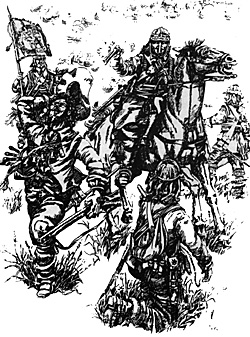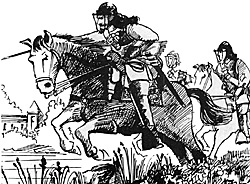
During the last few years two of the larger regiments in the King's Army, Sir Thomas Blackwell's and Sir Thomas Tyldesley's, have been coming together at major musters to form the Duke of York's Brigade. Fielding a proportion of rather better than one musketeer for each pikeman, it forms a strong battalion capable not merely of drawing up in the classic Dutch order, but is strong enough to fight effectively in that order. Indeed, as brigade commander, it has been my happy experience that employing 17th century formations and drills in a realistic manner is not merely "possible" but downright essential.
The same problems which faced 17th Century officers arise and the drillbooks really do provide the answers. It is simply not possible to effectively replicate battalion drills with a mere fifty men, but with over a hundred in something like the proper proportions of musketeers to pikemen, the drills, for the first time, make sense and also, interalia, it is possible to appreciate WHY.
One of the most frequently reproduced prints by Jacob De Geyhn shows a pikeman crouching in an aggressive manner, holding his pike at an angle with the butt jammed into the ground by his right foot, while he starts to draw his sword with his right hand. The posture is usually labelled "Charge for Horse", though the actual words of command given by De Geyhn are a surprisingly pedestrian "Charge your pike against the right foot and draw your sword". The original Dutch text has an equally long- winded "Teghen u rechter voet n Spies velt, encle u ghevver treckt".
Both phrases seem rather too calm and measured for the likely circumstances in which such gymnastics might have to be performed, and God help a company if its Captain had the stammers.
Then there is the matter of the Scots style "schiltron". Most re-enactors seem to have decided that the proper way to respond to a cavalry charge is for the pikemen to form a huddle, charging their pikes against their right feet in all directions while the musketeers pack around the outside, sheltering under the pikes to look like a combination of Bannockburn and Custer's last stand.
The disadvantages of such a proceeding can be perceived even by small re- enactment units and are even more pronounced with a large realistically sized one, such as the Duke of York's. Horrid confusion is sufficient to be going on with and I won't even bother to discuss just how effective it might or might not be against a REAL cavalry charge. So did it really happen that way?
The short answer would appear to be a resounding no. William Barriffe does discuss the forming of a square; a proper one with right-angled corners. However the context is clearly one in which the infantry can more or less take all the time they need to carry out the manoeuvre neatly. An obvious location might be a drill display featuring as much synchronised formation dancing as the modern Trooping of the Colours ceremony, on a nice flat parade ground. Or at best it might form part of the initial deployment by a General expecting to be assailed by an army, such as the Turks, which boasted an overwhelming superiority in cavalry. The timing involved appears to be rather more on a par with forming a wagon laager than with forming the rather simpler Napoleonic square as seen at Waterloo.
Reality
What really appears to have happened, except of course on those rather embarrassingly frequent occasions when the hapless infantry simply ran away, is described by Richard Elton, A Parliamentarian officer with pre-war experience in the Society of the Military Garden, one of the more influential of the military clubs then popular in London:
- "In my opinion the best way of
opposing the Horse charge is that which we
learned of our ever honourable Captain, Major
Henry Tillier, in the Military Garden; which
was, Files closing to the midst to their closest
order, insomuch that there was not above half
a foot intervall of ground between File and
File, the pikes porting, and after closing their
ranks forward so close, that they locked
themselves within one another, and then
charged on. Which in my judgement is so
secure a way from routing, that it is
impossible for any body of horse to enter
therein."
Tillier was a professional soldier, perhaps a French Huguenot, who had served at Cadiz, the Isle of Rhe, and in the Low Countries. During the Civil War he came over from Ireland with a regiment and served as Prince Rupert's Major General of the Foot. His methods were certainly employed during the Civil War. Accounts of the London Trained Bands' stand against the Royalist horse at I Newbury do not appear to describe how they faced them but it would be surprising if they did not follow the method taught them by Tillier, Royalist regiments certainly did.
 Here is Slingsby's account of how the
Royalist foot saw off Hesilrige's Horse at
Cheriton:
Here is Slingsby's account of how the
Royalist foot saw off Hesilrige's Horse at
Cheriton:
- "the Foot keeping theire ground in a
close body, not firing till within two pikes
length, and then three ranckes art a time, after
turning up the butt end of theire musketts,
charging thcirc pikes, and standing close,
preserv'd themselves and slew many of the
enemy."
One might safely say that they were following Tillier's instructions, as related by Elton, to the letter. Similarly at Nascby the [historical] Duke of York's regiment, while moving forward into the attack was itself assailed in flank by Ireton. Although Sprigge is not very forthcoming on just what went wrong it is quite clear that the Duke of York's had no opportunity to form a "schiltron", far less a square, and yet they not only beat off the Parliamentarian cavalry but even managed to take Ireton prisoner.
Some years later, at the Dunes in 1658 the boot was on the other foot and the Duke himself described what happened when he led a cavalry charge upon some English foot:
- "Tis very observable that when we
had broken into this battalion, and were gott
amongst them, not so much as one single man
of them asked for quarter, or threw down his
arms, but every one defended himself to the
last; so that we ran as great a danger by the
butt end of their muskets as by the volley
which they had given us. And one of them had
infallibly knocked mee off my horse, if I had
not prevented him when he was just ready to
have discharged his blow by a stroke which I
gave with my sword over the face, which laid
him along upon the ground."
This too has been the experience of the recreated Duke of York's. In the first place the pikemen closed up and charging their pikes forward rather than outwards in a circle, form a rather more impenetrable thicket which really does stop cavalry, while the musketeers are just as capable of giving a good account of themselves as their 17th Century forebears. Obviously the safety considerations of re- enactments prevent the cavalry from actually charging home in earnest - which is why the silly "schiltrons" have survived for so long, but even if they did come down in a determined manner the pikes would put a sufficient brake upon them to enable the musketeers to fight them off.
Moreover, as the Duke of York's demonstrated at the Aldershot muster last year and on a number of occasions since, it is possible by using this method to actually keep moving forward and indeed to follow the happy precedent of their historical forebears and actually drive off enemy cavalry, rather than sitting around waiting for them to get bored enough to go and annoy somebody else.
So there we have it, the documentary evidence and the practical experiment made possible by fielding something which actually looks and functions like a 17th Century infantry battalion, in happy conjunction.
Notes and Queries has in the past carried discussion on the practical value [to the historian] of re-enactment. In the past it has been agreed that they have in fact little to offer beyond some practical experience of how quickly a matchlock musket can really be loaded and fired, however by fielding realistic formations such as the Duke of York's Brigade it is, as this article shows, possible to do much more.
Back to English Civil War Times No. 45 Table of Contents
Back to English Civil War Times List of Issues
Back to Master Magazine List
© Copyright 1992 by Partizan Press
This article appears in MagWeb (Magazine Web) on the Internet World Wide Web.
Other military history articles and gaming articles are available at http://www.magweb.com